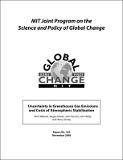| dc.contributor.author | Webster, Mort D. | |
| dc.contributor.author | Paltsev, Sergey | |
| dc.contributor.author | Parsons, John E. | |
| dc.contributor.author | Reilly, John M. | |
| dc.contributor.author | Jacoby, Henry D. | |
| dc.date.accessioned | 2009-02-23T17:27:16Z | |
| dc.date.available | 2009-02-23T17:27:16Z | |
| dc.date.issued | 2008-11 | |
| dc.identifier.uri | http://globalchange.mit.edu/pubs/abstract.php?publication_id=974 | |
| dc.identifier.uri | http://hdl.handle.net/1721.1/44623 | |
| dc.description | Abstract and PDF report are also available on the MIT Joint Program on the Science and Policy of Global Change website (http://globalchange.mit.edu/). | en |
| dc.description.abstract | We explore the uncertainty in projections of emissions, and costs of atmospheric stabilization applying the MIT Emissions Prediction and Policy Analysis model, a computable general equilibrium model of the global economy. Monte Carlo simulation with Latin Hypercube Sampling is applied to draw 400 samples from probability distributions for 100 parameters in the EPPA model, including labor productivity growth rates, energy efficiency trends, elasticities of substitution, costs of advanced technologies, fossil fuel resource availability, and trends in emissions factors for urban pollutants. The resulting uncertainty in emissions and global costs is explored under a scenario assuming no climate policy and four different targets for stabilization of atmospheric greenhouse gas concentrations. We find that most of the IPCC emissions scenarios are outside the 90% probability range of emissions in the absence of climate policy, and are consistent with atmospheric stabilization scenarios. We find considerable uncertainty in the emissions prices under stabilization. For example, the CO2 price in 2060 under an emissions constraint targeted to achieve stabilization at 650 ppm has a 90% range of $14 to $88 per ton CO2, and a 450 ppm target in 2060 has a range of $241 to $758. We also explore the relative contribution of uncertainty in different parameters to the resulting uncertainty in emissions and costs and find that, despite the significant uncertainty in future energy supply technologies, the largest drivers of uncertainty in costs of atmospheric stabilization are energy demand parameters, including elasticities of substitution and energy efficiency trends. | en |
| dc.description.sponsorship | The authors gratefully acknowledge the financial support for this work provided by the MIT Joint Program on the Science and Policy of Global Change through a consortium of industrial sponsors and Federal grants. | en |
| dc.language.iso | en_US | en |
| dc.publisher | MIT Joint Program on the Science and Policy of Global Change | en |
| dc.relation.ispartofseries | ;Report no. 165 | |
| dc.title | Uncertainty in Greenhouse Emissions and Costs of Atmospheric Stabilization | en |
| dc.type | Technical Report | en |
| dc.identifier.citation | Report no. 165 | en |
